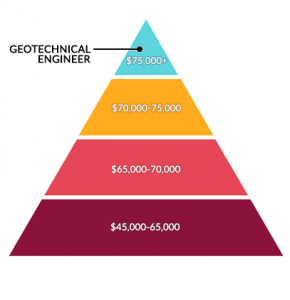Geotheta Fundamentals Explained
Geotheta Fundamentals Explained
Blog Article
The Single Strategy To Use For Geotheta
Table of Contents5 Easy Facts About Geotheta ExplainedThe smart Trick of Geotheta That Nobody is DiscussingHow Geotheta can Save You Time, Stress, and Money.Geotheta Things To Know Before You Buy
They collaborate with civil engineers, structural designers, engineers, and various other professionals to incorporate geotechnical considerations right into the total job design and building procedure. This needs efficient team effort, sychronisation, and interaction to make sure that the geotechnical aspects straighten with the job goals and satisfy regulatory needs.Mining & Products Design: Principles of drilling, penetration rates, and aspects influencing the option of exploration method. Attributes of dynamites, firing systems and blast patterns. Blasting strategies in surface area and below ground functions. Special blowing up techniques at excavation perimeters. Resonance and noise control. Mechanical and constant techniques to fragmentation, including longwall shearing and fullface boring.
Modelling of piece and particle size circulations; comminution as a transfer feature. Comminution technology: crushing, grinding, dimension category. Integrated evaluation of fragmentation and comminution procedures. Used by: Mining & Materials Design.
The Best Strategy To Use For Geotheta
Bachelor's degree programs in civil, geotechnical, geological, and environmental design normally last 4 years and consist of basic education courses in English, social scientific research, and the liberal arts, as well as courses in innovative maths, architectural geology, and fluid mineralogy. (https://www.producthunt.com/@geotheta1)
Geotechnical engineering entails the evaluation of the dirt and rock problems at a certain website, and their implications for the growth of that website. As most frameworks rely upon the ground for assistance, it lacks surprise that a detailed understanding of the ground conditions, and the viability of structure systems, are vital to the long-term stability and performance of the building or structure.
Being experts in the examination of geological developments and ground behavior, geotechnical engineers carry out clinical investigations and testing to comprehend the influence these geological developments might carry the style and building and construction of structure, civil and infrastructure projects. This knowledge is critical for the layout and building and construction of structures, roads, passages, dams, bridges, and water and sewer system.
The geotechnical group at Douglas Partners regularly talk to designers, layout designers, developers, and building contractors to make suggestions on style and growth proposals to ensure that the developed structures are suitably made for the ground problems. The style of footing systems requires to consider the weight of the framework, the capacity of the ground to support that weight together with motion tolerances and reliable building.
The 25-Second Trick For Geotheta
This task is substantially streamlined by the use our Douglas Map geospatial platform which makes this details easily accessible in a very easy to use internet internet browser interface. A geotechnical designer will certainly direct the drilling of boreholes and examination pits to accumulate soil and various other samples, and also examine surface functions and ground direct exposures to form a geotechnical design of the subsurface problems.
Depending on the project type and ground problems ran into, laboratory testing might to name a few points examine toughness, compressibility, sensitivity and/or leaks in the structure of dirt and rock samples. Hereafter data is accumulated and looked at, the results are utilized for a geotechnical design of the site, which is generally provided as areas throughout the website.

A geotechnical examination by nature can just examine the ground problems at the locations drilled or excavated. Natural variants in dirt and rock problems can take place throughout a website and in between examination locations. It is as a result excellent technique that the geotechnical engineer be kept throughout construction of the job to give on-site confirmation that the ground conditions experienced follow the assumptions and recommendations given in the geotechnical examination record.
The Main Principles Of Geotheta
Geotechnical engineers utilize their in-depth understanding of soil and rock to evaluate threat and resolve problems on varied facilities projectsGeotechnical design is a specialist branch of civil design which takes a look at the practices of earth products and the application of soil and rock technicians. Geotechnical Engineers. As a geotechnical designer, you will evaluate the physical, mechanical and chemical homes of soil and rock in order to develop foundations, maintaining structures and earthworks
Geotechnical engineering is very closely linked to and overlaps with, both design geology and ground engineering - https://allmyfaves.com/geotheta?tab=Geotheta. It's possible to specialise in geotechnics or benefit a geotechnical firm yet be called a design geologist or a ground designer. As a geotechnical engineer, you'll require to: develop and maintain relationships with customers and other specialists associated with the site, throughout each projectmaintain security criteria on over at this website website bear in mind price effects when you make recommendationsstudy geological maps and aerial pictures from a variety of resources and from different time periodsexamine building and construction prepares to see exactly how feasible they are based upon your understanding of the siteinvestigate risks or geological hazards for the sitesearch for eco sensitive attributes, such as garbage dump start to establish valid and interpretive ground modelsplan area investigationsdrill and analyse examples of bedrock, soil, groundwater and extra products oversee other experts on sitesolve technological problems as they occur, such as unanticipated structures at drill sitesmonitor problems throughout and after building to make sure structures are secure in the short and lengthy termadding data collected on website to your initial researchcreating geotechnical estimations, drawings, and two or three-dimensional computer system designs analyzing the datamaking referrals about the suggested use of the website

Report this page